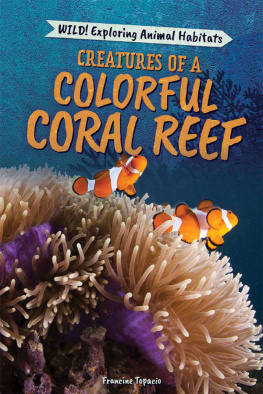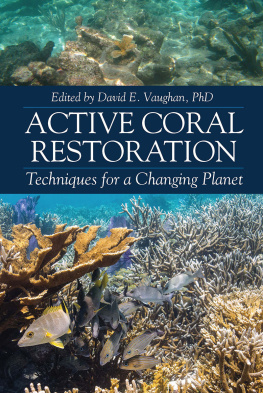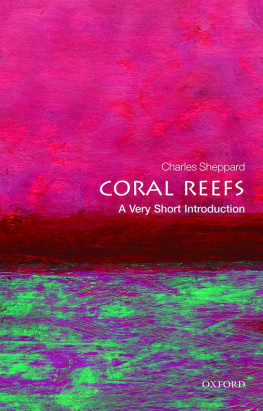Gail Gibbons - Coral Reefs
Here you can read online Gail Gibbons - Coral Reefs full text of the book (entire story) in english for free. Download pdf and epub, get meaning, cover and reviews about this ebook. year: 2018, publisher: CNPeReading, genre: Romance novel. Description of the work, (preface) as well as reviews are available. Best literature library LitArk.com created for fans of good reading and offers a wide selection of genres:
Romance novel
Science fiction
Adventure
Detective
Science
History
Home and family
Prose
Art
Politics
Computer
Non-fiction
Religion
Business
Children
Humor
Choose a favorite category and find really read worthwhile books. Enjoy immersion in the world of imagination, feel the emotions of the characters or learn something new for yourself, make an fascinating discovery.

- Book:Coral Reefs
- Author:
- Publisher:CNPeReading
- Genre:
- Year:2018
- Rating:4 / 5
- Favourites:Add to favourites
- Your mark:
- 80
- 1
- 2
- 3
- 4
- 5
Coral Reefs: summary, description and annotation
We offer to read an annotation, description, summary or preface (depends on what the author of the book "Coral Reefs" wrote himself). If you haven't found the necessary information about the book — write in the comments, we will try to find it.
Coral Reefs — read online for free the complete book (whole text) full work
Below is the text of the book, divided by pages. System saving the place of the last page read, allows you to conveniently read the book "Coral Reefs" online for free, without having to search again every time where you left off. Put a bookmark, and you can go to the page where you finished reading at any time.
Font size:
Interval:
Bookmark:
Coral Reefs by Charles Darwin EDITORIAL NOTE.
Although in some respects more technical in their subjects and style than Darwin's "Journal," the books here reprinted will never lose their value and interest for the originality of the observations they contain. Many parts of them are admirably adapted for giving an insight into problems regarding the structure and changes of the earth's surface, and in fact they form a charming introduction to physical geology and physiography in their application to special domains. The books themselves cannot be obtained for many times the price of the present volume, and both the general reader, who desires to know more of Darwin's work, and the student of geology, who naturally wishes to know how a master mind reasoned on most important geological subjects, will be glad of the opportunity of possessing them in a convenient and cheap form.
The three introductions, which my friend Professor Judd has kindly furnished, give critical and historical information which makes this edition of special value.
G.T.B.
CORAL REEFS.
TABLE OF CONTENTS.
CRITICAL INTRODUCTION.
INTRODUCTION.
SECTION 1.I.--DESCRIPTION OF KEELING ATOLL.
Corals on the outer margin.--Zone of Nulliporae.--Exterior reef.--Islets.-
Coral-conglomerate.--Lagoon.--Calcareous sediment.--Scari and Holuthuriae subsisting on corals.--Changes in the condition of the reefs and islets.-
Probable subsidence of the atoll.--Future state of the lagoon.
SECTION 1.II.--GENERAL DESCRIPTION OF ATOLLS.
General form and size of atolls, their reefs and islets.--External slope.-
Zone of Nulliporae.--Conglomerate.--Depth of lagoons.--Sediment.--Reefs submerged wholly or in part.--Breaches in the reef.--Ledge-formed shores round certain lagoons.--Conversion of lagoons into land.
SECTION 1.III.--ATOLLS OF THE MALDIVA ARCHIPELAGO--GREAT CHAGOS BANK.
Maldiva Archipelago.--Ring-formed reefs, marginal and central.--Great depths in the lagoons of the southern atolls.--Reefs in the lagoons all rising to the surface.--Position of islets and breaches in the reefs, with respect to the prevalent winds and action of the waves.--Destruction of islets.--Connection in the position and submarine foundation of distinct atolls.--The apparent disseverment of large atolls.--The Great Chagos Bank.--Its submerged condition and extraordinary structure.
Closely resemble in general form and structure atoll-reefs.--Width and depth of the lagoon-channels.--Breaches through the reef in front of valleys, and generally on the leeward side.--Checks to the filling up of the lagoon-channels.--Size and constitution of the encircled islands.-
Number of islands within the same reef.--Barrier-reefs of New Caledonia and Australia.--Position of the reef relative to the slope of the adjoining land.--Probable great thickness of barrier-reefs.
Reefs of Mauritius.--Shallow channel within the reef.--Its slow filling up.--Currents of water formed within it.--Upraised reefs.--Narrow fringing-reefs in deep seas.--Reefs on the coast of E. Africa and of Brazil.--Fringing-reefs in very shallow seas, round banks of sediment and on worn-down islands.--Fringing-reefs affected by currents of the sea.
--Coral coating the bottom of the sea, but not forming reefs.
CHAPTER IV.--ON THE DISTRIBUTION AND GROWTH OF CORAL-REEFS.
SECTION 4.I.--ON THE DISTRIBUTION OF CORAL-REEFS, AND ON THE CONDITIONS
FAVOURABLE TO THEIR INCREASE.
SECTION 4.II.--ON THE RATE OF GROWTH OF CORAL-REEFS.
SECTION 4.III.--ON THE DEPTHS AT WHICH REEF-BUILDING POLYPIFERS CAN LIVE.
CHAPTER V.--THEORY OF THE FORMATION OF THE DIFFERENT CLASSES OF
CORAL-REEFS.
The atolls of the larger archipelagoes are not formed on submerged craters, or on banks of sediment.--Immense areas interspersed with atolls.--Recent changes in their state.--The origin of barrier-reefs and of atolls.--Their relative forms.--The step-formed ledges and walls round the shores of some lagoons.--The ring-formed reefs of the Maldiva atolls.--The submerged condition of parts or of the whole of some annular reefs.--The disseverment of large atolls.--The union of atolls by linear reefs.--The Great Chagos Bank.--Objections, from the area and amount of subsidence required by the theory, considered.--The probable composition of the lower parts of atolls.
CHAPTER VI.--ON THE DISTRIBUTION OF CORAL-REEFS WITH REFERENCE TO THE
THEORY OF THEIR FORMATION.
Description of the coloured map.--Proximity of atolls and barrier-reefs.-
Relation in form and position of atolls with ordinary islands.--Direct evidence of subsidence difficult to be detected.--Proofs of recent elevation where fringing-reefs occur.--Oscillations of level.--Absence of active volcanoes in the areas of subsidence.--Immensity of the areas which have been elevated and have subsided.--Their relation to the present distribution of the land.--Areas of subsidence elongated, their intersection and alternation with those of elevation.--Amount and slow rate of the subsidence.--Recapitulation.
APPENDIX.
Containing a detailed description of the reefs and islands in Plate III.
INDEX.
THE STRUCTURE AND DISTRIBUTION OF CORAL REEFS.
CRITICAL INTRODUCTION.
A scientific discovery is the outcome of an interesting process of evolution in the mind of its author. When we are able to detect the germs of thought in which such a discovery has originated, and to trace the successive stages of the reasoning by which the crude idea has developed into an epoch-making book, we have the materials for reconstructing an important chapter of scientific history. Such a contribution to the story of the "making of science" may be furnished in respect to Darwin's famous theory of coral-reefs, and the clearly reasoned treatise in which it was first fully set forth.
The subject of corals and coral-reefs is one concerning which much popular misconception has always prevailed. The misleading comparison of coral-rock with the combs of bees and the nests of wasps is perhaps responsible for much of this misunderstanding; one writer has indeed described a coral-reef as being "built by fishes by means of their teeth." Scarcely less misleading, however, are the references we so frequently meet with, both in prose and verse, to the "skill," "industry," and "perseverance" of the "coral-insect" in "building" his "home." As well might we praise men for their cleverness in making their own skeletons, and laud their assiduity in filling churchyards with the same. The polyps and other organisms, whose remains accumulate to form a coral-reef, simply live and perform their natural functions, and then die, leaving behind them, in the natural course of events, the hard calcareous portions of their structures to add to the growing reef.
While the forms of coral-reefs and coral-islands are sometimes very remarkable and worthy of attentive study, there is no ground, it need scarcely be added, for the suggestion that they afford proofs of design on the part of the living builders, or that, in the words of Flinders, they constitute breastworks, defending the workshops from whence "infant colonies might be safely sent forth."
It was not till the beginning of the present century that travellers like Beechey, Chamisso, Quoy and Gaimard, Moresby, Nelson, and others, began to collect accurate details concerning the forms and structure of coral-masses, and to make such observations on the habits of reef-forming polyps, as might serve as a basis for safe reasoning concerning the origin of coral-reefs and islands. In the second volume of Lyell's "Principles of Geology," published in 1832, the final chapter gives an admirable summary of all that was then known on the subject. At that time, the ring-form of the atolls was almost universally regarded as a proof that they had grown up on submerged volcanic craters; and Lyell gave his powerful support to that theory.
Font size:
Interval:
Bookmark:
Similar books «Coral Reefs»
Look at similar books to Coral Reefs. We have selected literature similar in name and meaning in the hope of providing readers with more options to find new, interesting, not yet read works.
Discussion, reviews of the book Coral Reefs and just readers' own opinions. Leave your comments, write what you think about the work, its meaning or the main characters. Specify what exactly you liked and what you didn't like, and why you think so.





